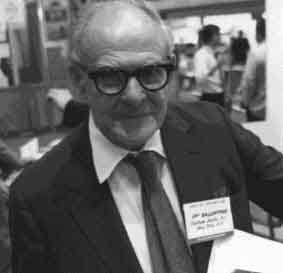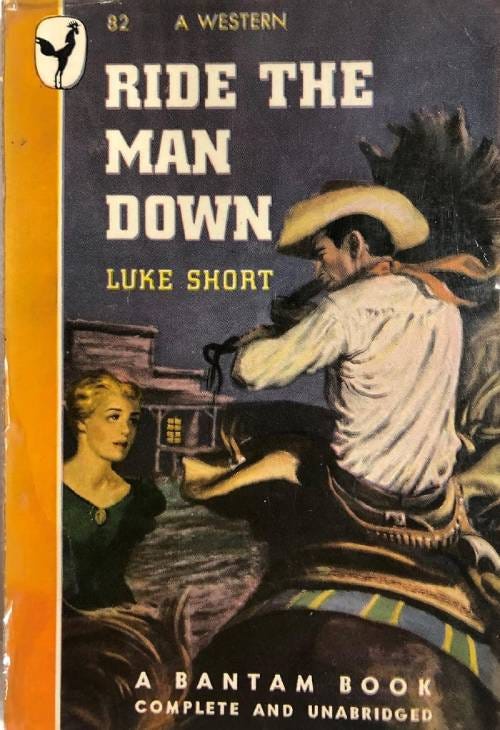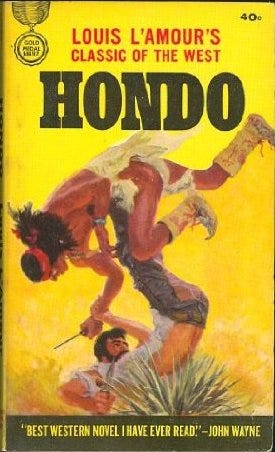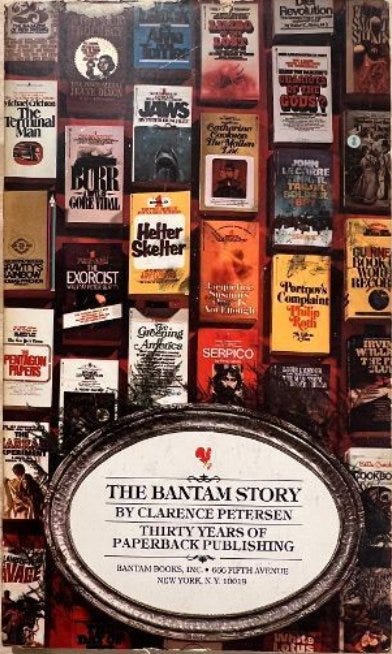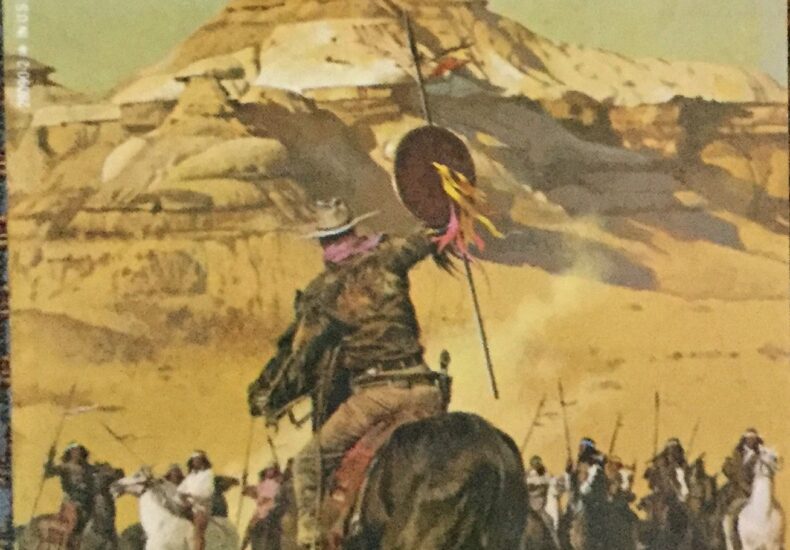
Ep 17- Bantam, Louis L’amour and the Paperback Western
Ian Ballantine was a young graduate student in 1939. He wrote a thesis on the economics of the paperback industry in the late 1930s that brought him to the attention of several paperback publishers. He opened the American branch of Penguin Books (a UK company) in 1939. Ian was primarily responsible for re-selling Penguins in the United States. However, World War 2 cut off his shipments from the UK, so he began to publish paperbacks himself. One change he made was to add illustrated covers to his paperbacks which were primarily sold through magazine distributors and needed an eye-catching cover to compete. But when Penguin founder Anthony Lane visited the U.S. Penguin offices after the war, he was appalled at these new illustrated covers. He demanded that the paperbacks be simply text and be color-coded like the British Penguins. Ian Ballantine refused and left the company.
Ian started his own company with his wife Betty Ballantine and secured funding from a major hardback publisher – Grosset & Dunlap who were eager to get into the paperback market. One ace that Ian carried with him was Curtis Publications, a major distributor of magazines and paperbacks. The new company needed and name and Bantam Books was born with a rooster as a symbol. The date was 1945.
Although Bantam Books is better known for their “Choose Your Own Adventure” books, their Star Trek: The Original Series short story adaptations, science fiction originals, the Bantam Classics, and a long series of books on World War 2, it was the Western that got the publisher on their feet with the works of Luke Short. Later, it was Louis L’amour who became their star writer.
The Bantam Western
The first twenty titles published by Bantam on January 3, 1946, included the western novel Nevada by Zane Grey. The company published four additional titles a month for the first few years with a print run of 200,000 copies each. Interestingly, the first 200 paperbacks published by Bantam included 25 Western titles and 21 mystery titles. Science fiction paperbacks began to be more popular in the fifties. The first sci-fi title published by Bantam was Donovan’s Brain by Curt Siodmak in 1950 with a wonderful cover by an unknown artist (sigh).
Cover design on the first 200 published Bantam paperbacks was initially bland, but once Ben Hibbs (Saturday Evening Post) took over they became very stylish and bold. Some covers brought $1000 to the artist whereas the general price for paperback covers at the time was $200-$300. One of my favorite early Bantam covers is the one for Luke Short’s Ride the Man Down (Bantam #82). The cover artist is unknown.
Bantam (along with several other paperback publishers) suffered from oversupply and was struggling financially with millions of paperbacks stuffing the shelves and many returns. Oscar Dystel was hired to right the ship which he did by the end of 1954. Bantam was sold many times over the next several decades, but Dystel managed to make Bantam one of the most powerful paperback publishers in the business by the time he retired in 1980. At that time, Bantam had 15% of the market with over $100,000 million in paperback sales.
At present, Bantam is part of the Penguin Random House publishing conglomerate.
Louis L’amour: The Most Popular Western Writer in History
It wasn’t until 1955 that Bantam began publishing Louis L’amour, a World War 2 veteran who started writing for the Western Pulps in 1946. He began his novel writing career in the 50s. Gold Medal was his initial publisher, but like other publishers of the time, they never published more than 3 novels from the same author in a year. Lamour sold novels to several different publishers until Bantam finally offered him an exclusive contract to publish three books a year. L’amour continued this formula for decades until by 2010 he had written over 100 novels published in over 10 languages with 320 million copies printed. He is the most popular Western writer in history and Bantam was his publisher.
Collectors should note that several early Bantam L’amour novels were paperback originals (PBO) meaning that they were published in paperback first. Here is a short list:
- 1958 Bantam #1853 Radigan
- 1959 Bantam #1905 The First Fast Draw
- 1960 Bantam #A-1933 The Daybreakers
- 1959 Bantam #1977 Taggart
These early Bantam PBOs are going for +$50 if you want to start collecting L’amour.
Why Read Louis L’Amour?
Westerns run cycles of popularity according to popular interest. The Western at present (2024) is not particularly popular if you look at the bestseller lists. But that could change. Part of the problem with the Western novel is that it is so formula-bound. However, that is exactly the appeal to readers of Westerns – they like the fact that the same cycle of stories and characters appears over and over. It’s comforting. That is why the vast majority of Western novels are like comfort food: once you consume it you don’t think about it again. And despite the critics, there is absolutely nothing wrong with reading for comfort.
Louis L’amour wrote to formula for almost every one of his 100 novels. His favorite trope is the “ranch romance” where a man and a woman meet, the man fights to be with his woman and eventually, they reunite and there is a happy ending. It would be a mistake, however, to think that this is all L’amour does with his stories. He is a keen observer of nature and cowboy rituals. His plots move forward at a fast paste and he is a compelling storyteller. Despite his reliance on stereotypes for characters, they often have qualities that make them interesting and sometimes compelling.
Hondo, his 1953 novel that began as a short story, was adapted into a film and then novelized by L’amour, is a good novel to start with. I recently re-read this novel and enjoyed it very much. Short (about 110 pages) and spare, Hondo’s plot moves forward very quickly. I was particularly taken with his description of nature and the even-handed treatment of Indian characters in the novel.
Another good entry point for reading L’amour is the first of his Sackett family series: Sackett (1961). This is the story of a pioneer family through several generations and is a wonderful story that takes many twists and turns. Note that Sackett is not the first chronological book in the Sackett timeline. The first is Sackett’s Land (1974).
SHOW NOTES
I’ve relied on The Bantam Story paperback (1970) for the historical background on Bantam Books. It’s an interesting read. Also, Jon Warren’s Official Price Guide to Paperbacks helped me in compiling the early westerns of Louis L’amour. It’s hopelessly out of date on prices, but it’s an excellent historical record. The official Louis L’amour website is a big help in understanding L’amour and his works. And the wikipedia entry on Louis L’amour is quite well-written and useful.
Note that the music for this episode is from uppbeat.io. Music license below:
Music from #Uppbeat (free for Creators!):
License code: O91BEC5C9LRB3USA
Archives
Calendar
| M | T | W | T | F | S | S |
|---|---|---|---|---|---|---|
| 1 | ||||||
| 2 | 3 | 4 | 5 | 6 | 7 | 8 |
| 9 | 10 | 11 | 12 | 13 | 14 | 15 |
| 16 | 17 | 18 | 19 | 20 | 21 | 22 |
| 23 | 24 | 25 | 26 | 27 | 28 | 29 |
| 30 | ||||||

